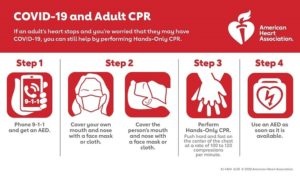
The American Heart Association (AHA) has compiled interim CPR guidelines to help rescuers treat cardiac arrest patients with suspected or confirmed COVID-19. The guidelines are in collaboration with the American Academy of Pediatrics, American Society of Anesthesiologists, American Association of Respiratory Care, The Society of Critical Care Anesthesiologists and American College of Emergency Physicians. They have been published in Circulation.
The aim of the revised guidelines, a press release reports, is to ensure that patients with or without COVID-19 who experience cardiac arrest have the best possible chance of survival without compromising the safety of rescuers. Principles for resuscitation in suspected and confirmed COVID-19 patients provided in the statement include:
- Reducing provider exposure to COVID-19. Limit personnel in the room or on the scene to only those essential for patient care.
- Prioritising oxygenation and ventilation strategies with lower aerosolisation risk. Emphasis has been placed on the use of hgh-efficiency particulate air (HEPA) filters for all ventilation and early and successful intubation with mechanical intubation to minimise the airborne spread of the virus.
- Considering the appropriateness of starting and continuing resuscitation. Healthcare systems and emergency agencies should institute policies to guide front-line providers in determining the appropriateness of starting and terminating CPR for patients with COVID-19, taking into account patient risk factors to estimate the likelihood of survival.
- Continuing to encourage bystander CPR and defibrillation, for with those willing and able, especially if they are household members who have already been exposed to the victim at home. For out-of-home cardiac arrests, a face mask or cloth covering the mouth and nose of the rescuer and/or victim may reduce the risk of transmission to a bystander during Hands-Only CPR.
Dana P Edelson (University of Chicago, Chicago, USA), corresponding author of the volunteer writing group, says: “CPR remains a critical component of care for many of our patients, particularly during this pandemic, but it does place rescuers at increased risk of COVID-19 exposure. This guidance draws on evolving science and expert opinion to help health systems and providers mitigate that risk with the hopes of maintaining the survival gains for cardiac arrest achieved over the past two decades.”
In addition to the guidelines, the AHA has released a free e-learning course to help health care providers understand the impact of the resuscitation guidelines.












